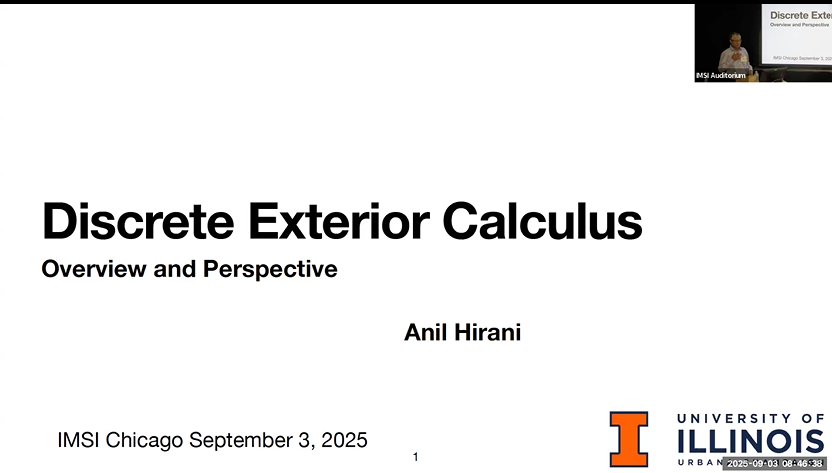Description
Back to topThe workshop aims to bring together differential geometers, computer scientists, engineers, and applied mathematicians to discuss and develop discrete exterior calculus (DEC). In the last two decades, DEC has progressively matured as a discretization of calculus on manifolds, and recent developments have made it suitable for vector bundle valued forms and discrete differential geometry. The workshop strives to be an inaugural platform for experts who have often worked independently of each other, providing a communication platform and facilitating new collaborative efforts. Speakers are being invited to discuss topics including discrete differential geometry, twisted forms, simplicial Ricci flow, discrete vector bundles with connection, intrinsic differential geometric formulations of fluid flow and elasticity, and applications of DEC in machine learning, fluid flow, photonics, quantum electrodynamics and other areas.
Lightning Talks and Poster Session
This workshop will include lightning talks and a poster session for early career researchers (including graduate students). If accepted, you will be asked to do both. In order to propose a lightning session talk and a poster, you must first register for the workshop, and then submit a proposal using the form that will become available on this page after you register. The registration form should not be used to propose a lightning session talk or poster.
The deadline for proposing is July 1, 2025. If your proposal is accepted, you should plan to attend the event in-person.
Organizers
Back to topSpeakers
Back to topSchedule
Speaker: Anil Hirani (University of Illinois at Urbana-Champaign)
Speaker: Stefano Stramigioli (University of Twente)
Speaker: Andrea Brugnoli (ISAE-SUPAERO and ICA-CNRS)
Speaker: Christopher Eldred (Sandia National Laboratory)
Speaker: Dzung Pham (Princeton University)
Speaker: Sanna Mönkölä (University of Jyväskylä)
Speaker: Evan Gawlik (Santa Clara University)
Speaker: Kaibo Hu (University of Oxford)
Speaker: Mathieu Desbrun (Inria and Ecole Polytechnique)
Speaker: Johnny Guzmán (Brown University)
Speaker: Snorre Christiansen (University of Oslo)
Speaker: Andreas Čap (University of Vienna)
Speaker: James Fairbanks (University of Florida)
Speaker: Lauri Kettunen (University of Jyväskylä)
Speaker: Nat Trask (University of Pennsylvania)
Videos
The magic of Exterior Calculus bridging Fundamental Physics to real Computations
Stefano Stramigioli
September 3, 2025
A linearly-implicit energy-momentum preserving scheme for geometrically nonlinear mechanics based on non-canonical Hamiltonian formulations
Andrea Brugnoli
September 3, 2025
Applications of Discrete Exterior Calculus: From Physical Modeling to High-Performance Computing
Sanna Mönkölä
September 3, 2025
Building Modeling and Simulation Tools on Discrete Exterior Calculus Foundations
James Fairbanks
September 5, 2025
Retaining the Structure of Second Order Boundary Value Problems in Finite Dimensional Settings
Lauri Kettunen
September 5, 2025















